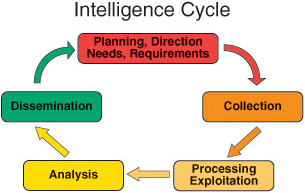Intelligence Analysis in a Cycle
Analysis resides within the larger intelligence cycle. The intelligence cycle determines the daily activities of the Intelligence Community. It starts with the needs of the intelligence "consumers' such as policymakers, military officials, and other decision makers who need intelligence for their activities. These requirements are sorted and prioritized within the Intelligence Community and are used to drive the collection activities of the Intelligence Community. The cycle, as depicted in the figure below, is repeated until an intelligence requirement has been satisfied.
The Intelligence Cycle is a concept that describes the general intelligence process in both a civilian or military intelligence agency or in law enforcement. The cycle is typically represented as a closed path of activities. Problems with a closed loop include an overall process that is no better than its weakest component and stove piping. In the traditional intelligence use of the term, stove piping keeps the output of different collection systems separated from one another. Stove piping prevents one discipline from cross-checking another and bypassing the regular analysis of raw intelligence by sending only raw intelligence that supports a particular position to the leadership.
Analysis is using information about the context of a situation, characterizing the known observables, and applying the appropriate statements of probability to anticipate future situations. Descriptions of the anticipated situations are developed from what may be inaccurate or deliberately deceptive information; therefore, the analyst must correlate the similarities among observations and develop a common "truth." A set of repeatable and useful problem-solving approaches is helpful and essential for analysts. Because of the nature of the intelligence problem and work, an analytic approach must be tolerant of deceptive information far more than the scientist performing an experiment. According to Richards Heuer, intelligence analysis involves incremental, iterative, refinement.
Intelligence Process
The term "intelligence process" refers to the steps of the cycle. Intelligence, as practiced in the United States, is commonly thought of as having five steps. Lowenthal (2006, p 55) added two phases for seven phases of the intelligence process as (1) requirements, (2) collection, (3) processing and exploitation, (4) analysis and production, (5) dissemination, (6) consumption, and (7) feedback. The following paraphrases Lowenthal (p 55):
- Requirements.
Identifying requirements means defining those questions to which intelligence is expected to make a contribution. Requirements also means specifying the collection of certain types of intelligence. The impulse is to say that all policy areas have intelligence requirements, which they do. However, since intelligence capabilities are limited, priorities must be set. - Collection.
Once requirements and priorities have been established, the intelligence is collected. Some requirements have specific types of collection; some may require several types of collection. Making these decisions is a key issue and the question of how much can or should be collected to meet each requirement. - Processing and Exploitation.
Collection produces information which must undergo processing and exploitation before it can be regarded as intelligence and given to analysts. Conversion includes translations, decryption, and interpretation. - Analysis and Production.
Analysis and production includes the integration, evaluation, and analysis of all available data, and the preparation of intelligence products, including quickly developed single-source, event-oriented reports and longer term all-source and intelligence studies. "All-source" intelligence analysis is done exclusively by the CIA, DIA, and the State Department's Bureau of Intelligence and Research. All-source analysts complete a more thorough evaluation and assessment of the collected information by integrating the information from other classified and unclassified sources.
Significantly, according to Lowenthal, most discussions of the intelligence process end with the dissemination and the intelligence having reached the policy makers. However, Lowenthal bundles dissemination with consumption and adds feedback:
- Dissemination and Consumption
Dissemination and Consumption are taken together by Lowenthal. The process of dissemination, or the process of moving intelligence from producers to consumers, is largely standardized, with consumption being assumed in the 5-step process. However, Lowenthal points out that policy makers are not pressed into action by the receipt of intelligence, and if and how they consume intelligence is key (Lowenthal p. 62). - Feedback.
A dialog between intelligence consumers and producers should occur before and continue after the intelligence has been received. The analyst should have some sense of how well their intelligence requirements are being met and address any adjustments that need to be made. Feedback assesses the degree to which the finished intelligence addresses the needs of the intelligence consumer and will determine if further collection and analysis is required.
